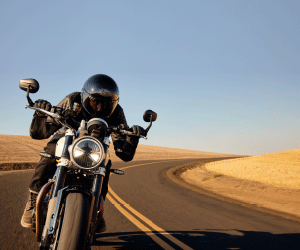We recently discovered that BMW has patented an unusual aerodynamic system designed to create downforce in corners, and now the company has applied for another patent that pursues the same goal, but in a very different way.
Winglets are already well established as a way to obtain straight-line downforce in racing motorcycles, helping to reduce wheelies, increase grip on straights and during braking at the highest level of competition. However, obtaining usable downforce in corners is much more difficult due to the fact that motorcycles lean. There are solutions, such as the ground-effect fairing shapes used by Aprilia and others in MotoGP, but these are temporary solutions and not the ideal answer to the problem.
BMW’s latest patent proposes perhaps the simplest solution of all: winglets that remain parallel to the ground even when the rest of the motorcycle leans. In MotoGP, where most of this aerodynamic work is taking place, this would be illegal. The rules clearly state: “Moving aerodynamic devices are prohibited; in this regard, any part of the Aero Body must be fixed so that active adjustment (e.g. connections, bearings, and any design that allows intentional change in shape/orientation/position) is not possible, nor is passive adjustment; in this regard, any part of the Aero Body, when mounted on the motorcycle under normal operating conditions, must have a maximum deflection of 10 mm at any point when a vertical load of 50 N is applied in the downward direction with a spherical steel penetrator with a radius of 20 mm.”
As a result, there has been little investment in the idea of active and movable aerodynamics by teams and manufacturers that invest their money in R&D in MotoGP. However, BMW does not compete in MotoGP, so perhaps they have a different perspective. The Bavarian company’s chosen racing series is the World Superbike Championship, where the rules are very different. The FIM’s WSBK regulations make it clear that active aerodynamics would be legal if a company wanted to use it, as long as the same equipment was installed as standard on the production model on which the racing motorcycle is based.


The WSBK rulebook states: “For active or dynamic aerodynamic parts, ONLY the approved standard mechanism can be used. The range of motion must be the same as that used by the homologated road machine in normal use – not the mechanical maximum.”
At the moment, it remains a debatable point. There are no competitors in WSBK who have active aerodynamic components on their road bikes, so no one has been able to use that part of the rulebook. But there have been studies on the idea. As early as 2019, Honda analyzed wings that would turn inward or outward depending on their need, but like fixed wings, they would still be more effective on straightaways than in curves. BMW’s latest patent firmly highlights curves, with articulated winglets connected to actuators that keep them horizontal regardless of the bike’s lean angle.
The patent does not go into much detail about the mechanical or electrical systems needed to operate the wings, instead seeking IP protection for the entire concept. However, it is not difficult to imagine that since instant measurement units (IMUs) installed in virtually all modern superbikes constantly monitor the lean angle, among other parameters, creating the computer system to keep the winglets level would be simple. After all, many of the cameras we see on TV already manage to stay vertical while the bike underneath them leans – the same idea could easily be applied to the wings.











